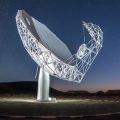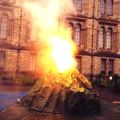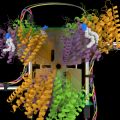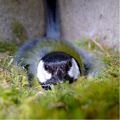
Blasting back to the Big Bang
Yesterday a giant blast levelled the top of a mountain, part of the 3000-metre peak of Cerro Armazones in Chile.
But this bang is nothing compared to the Big Bang that the telescope the mountain was blasted for will be studying. The European-Extremely Large Telescope (E-ELT) will be the world's largest optical and infrared telescope and will help astronomers to observe the early Universe, just a few hundred million years after the Big Bang, in unprecedented detail.
The E-ELT is being built by the European Southern Observatory (ESO), an international collaboration supported by the UK’s Science and Technology Facilities Council. Oxford University scientists are playing a key role in the project: I asked Aprajita Verma, Deputy Project Scientist for the UK E-ELT project at Oxford University's Department of Physics, about what makes the telescope so special and what discoveries it could make…
OxSciBlog: What questions about the Universe will E-ELT investigate?
Aprajita Verma: There are so many! The E-ELT is designed to be a versatile telescope that will answer a huge range of questions in astrophysics and cosmology. Some examples are understanding the first stars and galaxies that formed after the Big Bang, studying extra-solar planets and looking for possible signs of life, and directly measuring the expansion of the Universe.
In extra-solar planets, finding planetary systems like our Solar System but around other stars in the Milky Way is a key driver for the E-ELT. In the last 20 years we've gone from the first discovery of exoplanets to the prospect of directly imaging and studying the atmospheres of exoplanets that are at Earth-like distances from their stars with the E-ELT.
There's a whole host of contemporary astrophysics problems that we can tackle with the power of the E-ELT but perhaps the most fascinating and exciting prospect are the things we just can't predict yet. When we make such an enormous scale change from the currently largest telescopes in operation (8-10m) to a 39m telescope we can expect the unexpected!
OSB: What makes E-ELT unique as an instrument?
AV: The E-ELT will be largest telescope of its kind in the world. The fact that it has a large primary mirror means that we can collect more light, so see deeper into the Universe but it also gives us the ability to observe objects in the Universe in exquisite detail.
The telescope incorporates a system that's called adaptive optics that basically corrects for the blurring caused by atmospheric turbulence. This allows us to get the best possible resolution from the telescope, that's dependent on the size of the mirror, rather than the atmosphere. Space telescopes, like the Hubble Space Telescope [HST], are put up there to get above the atmosphere to avoid this blurring producing some of the most iconic images of the sky we know. But it's simply not feasible to put a mirror of the size of the E-ELT into space, so what the E-ELT can deliver is space quality images but from the ground.
The E-ELT images will in fact be 16 times sharper than the HST! There are several advantages of having a ground-based telescope, we can take advantage of new technologies as they get developed, we can maintain the telescope, we can guarantee a long lifetime (not true of most space telescopes). The E-ELT's baseline operation is at least 30 years but we can expect it to be around taking images and spectra of astronomical objects for several decades to come.
OSB: How are Oxford scientists involved in the project?
AV: Oxford scientists are heavily involved in two main aspects: Instrumentation and science. For the former this means designing and building what can be thought of as the "eyes" of the telescope. The primary mirror collects the light but then this is passed through four further mirrors to a suite of instruments that span different capabilities. These instruments then record the light in different ways.
For example, for the first phase of the telescope there will be two instruments, a camera that takes very high resolution images of the sky called MICADO, and an instrument called HARMONI that is being led by Professor Niranjan Thatte. HARMONI is as an integral field spectrograph or imaging spectrograph. This means that you get an image, but for each pixel in that image you get a spectrum. This is an extremely powerful and versatile instrument, and it's a credit to Professor Thatte and his team that ESO selected their instrument to be available at early light.
We're also involved in other instruments foreseen for the E-ELT, a multi object spectrograph that can take simultaneous spectra of objects in the sky over a wide field (ELT-MOS), and the technologically challenging instrument dedicated to studying extra-solar planets (ELT-PCS).
Several Oxford scientists will be future users of the E-ELT and are therefore very interested in understanding the capabilities of the telescope and how that will aid their research and the UK astronomical community. Professor Isobel Hook and I work with the UK instrument teams and the community to promote and develop the science case for the telescope. Professor Hook has led ESO’s E-ELT Science Working Group that defined the key science cases for the telescope, and the ESO's E-ELT Project Science Team.
OSB: After the ground-breaking what are the next big milestones?
AV: The next big steps for E-ELT are the dome and main structure contracts that are currently out for tender during the next months. Once the tender process has been completed this means that actual construction of the telescope will start.
The contract for the primary mirror production is also a major milestone. The primary mirror of the E-ELT is so large that it can only be constructed by making it in smaller parts. In fact the E-ELT primary mirror is made up of 798 segments, each 1.4m across. Around 1000 segments will be made including spares, so this is a major contract. It's a challenging contract to fulfil as the precision on the smoothness of the mirror surface is very high, it's equivalent to ripples of a few centimetres on the surface of the Atlantic Ocean! To preserve the quality of the primary mirror, 1-3 segments will be removed for cleaning and coating each day!
OSB: What puzzle from your own area of research do you hope E-ELT might solve?
AV: I'm really excited about the prospects for using the E-ELT to push the boundaries of the observable Universe to the first stars and galaxies that formed after the Big Bang. We can only go so far with current ground based facilities and the E-ELT might be able to capture galaxies that were in place in the Universe at only 2-3% of its current age (or about 300 million years after the Big Bang). This will give us tremendous insight on how galaxies first began to form in this very young Universe. We think that about 700 million years later, galaxies like the Milky Way just started their lives and the E-ELT will be able to capture these objects in unprecedented detail and help us understand how our own galaxy might have started its life.
 MeerKAT is shape of things to come
MeerKAT is shape of things to come Explosions, volcanoes & risks
Explosions, volcanoes & risks Unfolding role of cell's gatekeepers
Unfolding role of cell's gatekeepers Bold birds show 'live fast, die young' attitude
Bold birds show 'live fast, die young' attitude Tamiflu: an analysis of all the data
Tamiflu: an analysis of all the data